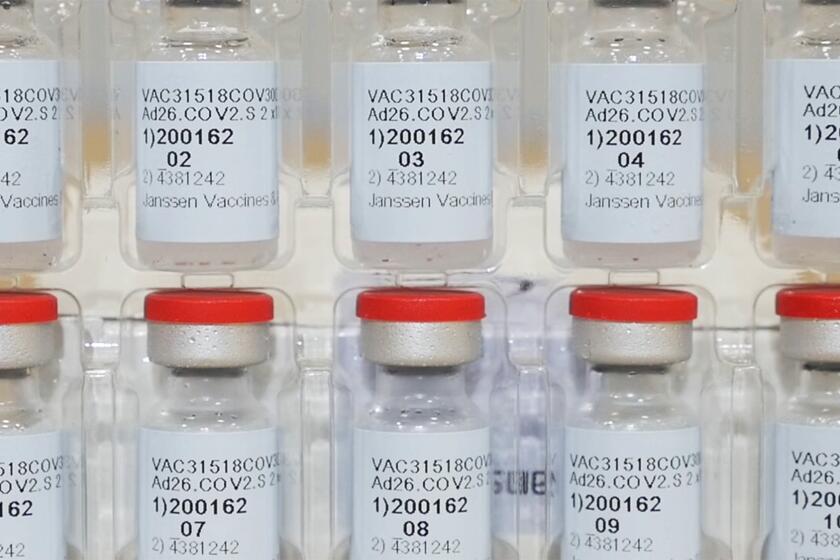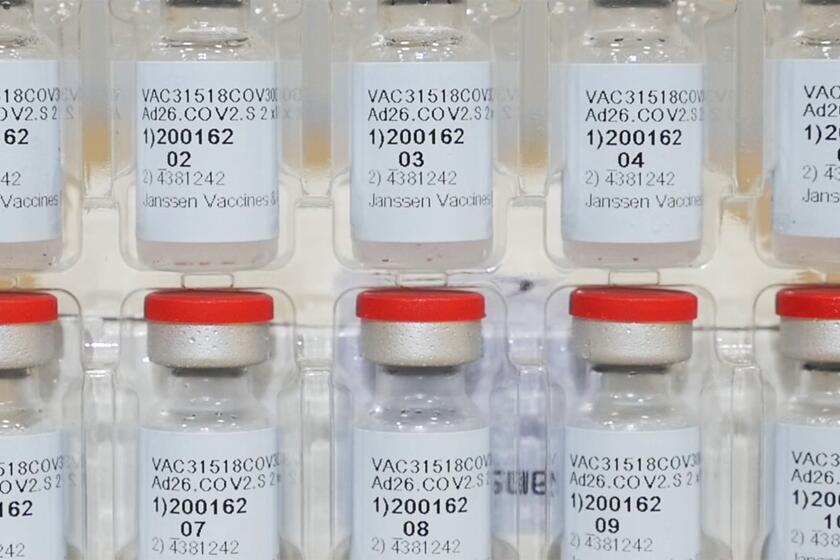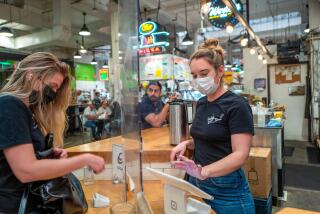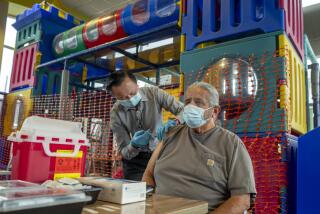L.A. County COVID-19 vaccine supply will tighten due to Johnson & Johnson shortage

- Share via
In the coming weeks, Los Angeles County’s supply of COVID-19 vaccine will tighten because of an expected shortage of shots manufactured by Johnson & Johnson — just as people with underlying health conditions become eligible for inoculations.
“The next two weeks, we’re not going to get any Johnson & Johnson [vaccine doses]. That’s a manufacturing production issue,” L.A. County Public Health Director Barbara Ferrer said Tuesday, warning that the vaccine supply in March will be tight.
The scarcity is not unique to Los Angeles. Gov. Gavin Newsom said Wednesday that the state doesn’t anticipate receiving additional doses of that particular vaccine “in the immediate term.”
While the next few weeks will remain “a constrained environment in terms of access to vaccines,” Newsom said during a briefing in South Gate that he’s hopeful a steadier and stronger stream is on the horizon and that things will “really start to move next month and then the month after.”
Health officials throughout the state have repeatedly cited insufficient supplies as their major obstacle toward more quickly and widely administering vaccines.
“All of us want to get the vaccine when it’s our turn, and everybody wants for it to be our turn today,” Newsom said.
The millions-deep queue of Californians eligible to be inoculated — which already includes people 65 and older, as well as essential workers in food and agriculture, education and child care, healthcare and emergency services — is set to further expand Monday, when those with qualifying health conditions can start reserving their places in line.
California is still finalizing the list of medical conditions that will qualify people under 65 for the COVID-19 shot starting next week, Ferrer said.
A state bulletin last month said that starting March 15 healthcare providers can use their judgment to vaccinate people ages 16 to 64 deemed to be at high risk for severe illness or death from COVID-19 because of health conditions like cancer, chronic kidney disease, chronic pulmonary disease, a compromised immune system as a result of an organ transplant, Down syndrome, pregnancy, sickle cell disease, heart conditions, severe obesity and Type 2 diabetes.
Ferrer expects hundreds of thousands of additional people in L.A. County with underlying conditions will become eligible for the vaccine.
“Our numbers are likely to go down slightly on how many doses we get, but we’re going to have many more people that are going to be eligible on Monday,” Ferrer said. “So, again, I feel bad always asking everybody to be somewhat patient, because even though it is your turn, it’s still going to be hard to get appointments.”
Ferrer suggested that people with underlying conditions contact their healthcare providers to ask about getting the vaccine. “The easiest way for you to get vaccinated is going to be to go to your provider, or if your provider has an arrangement with a network, to get vaccinated,” Ferrer said.
The state has also classified the following groups as eligible for the vaccine: custodians and janitors; public transit workers; airport ground crew workers; social workers who handle cases of violence, abuse or neglect; and foster parents providing emergency housing for young people, Ferrer said. L.A. County is coordinating with unions and employers to set up vaccination sites and make appointments for these newly eligible groups.
Vaccine appointments for custodians and janitorial workers could be available at two large county-run vaccination sites as soon as Saturday and Sunday at the Forum in Inglewood and at the L.A. County Office of Education in Downey on Saturday.
From schools to theme parks to restaurants, L.A. steps rapidly toward a post-pandemic world.
The continuing cadence of vaccinations and declining coronavirus cases has pushed some counties, including L.A., to the verge of a wider economic reopening.
Once 2 million doses have been administered to residents in California’s most disadvantaged areas, the state will relax the threshold required for a county to move from the most restrictive purple category of the state’s four-tier, color-coded reopening roadmap into the more permissive red tier.
Newsom said it’s possible that the state could hit its 2 million dose target by Friday — positioning eligible counties to potentially begin lifting business restrictions as soon as this weekend.
It’s unclear at this point just how quickly counties will opt to move, however, as local-level health officials can keep stricter rules in place if they feel it’s warranted.
A topic of particular interest in L.A. County has been the potential resumption of indoor dining, which is allowed at limited capacity under the red tier. Indoor operations of restaurant dining rooms have been off-limits in the county since last July.
Ferrer has not specified how, or whether, the county’s rules might ultimately differ from what the state allows, as health officials are still discussing that with the Board of Supervisors and representatives from relevant business sectors.
“We’re working on the guidances for restaurants, for movie theaters, for personal care sites — all of which have really different opportunities while we’re in the red tier,” she said during a briefing Wednesday. “Those should be released tomorrow.”
If the county remains on the right path, Ferrer said entering the even more lenient orange tier could become a realistic possibility in as soon as a few weeks.
“It’s not just putting out new guidance, it’s having everybody take to heart the need to still take a lot of protections so that we keep each other safe,” she said.
Newsom signaled that state officials are working on an even more lenient tier. As the state gets closer to herd immunity, “we will start to make it clear that these tiers [are] temporary, they’re not permanent. And there’s something beyond orange, and yellow, and that green tier will present itself.”
The COVID-19 vaccine from Johnson & Johnson will save lives. But public health officials must address the false narrative that it’s a lesser vaccine.
Adding to the complexity of vaccination efforts, however, is the growing dissatisfaction among officials in counties that are being forced to use the state’s flawed My Turn appointment system to manage vaccinations.
Dr. Christina Ghaly, the health services director for L.A. County, said adopting the My Turn system for the county’s public hospital system would disrupt her agency’s vaccination efforts, resulting in inefficiency and hardships.
Ghaly said her department would like to be exempted from any state requirement to use My Turn and continue to use its own electronic health record system to manage vaccinations, and later upload information to a state immunization registry. Shifting to My Turn would force clerks to enter data twice — once in the county health system’s database and again in the My Turn system, she noted.
Ghaly called My Turn a “wholly parallel and an unnecessary system.”
Ferrer backed Ghaly’s concerns. “Please don’t add a layer of complexity to healthcare providers that are already doing a good job,” Ferrer said.
The My Turn system has also been faulted for previously relying on access codes that were distributed to people in underserved communities to receive vaccines. The codes leaked out, resulting in people from wealthier and predominantly white communities showing up at vaccination sites in lower income and mostly nonwhite neighborhoods, undercutting efforts to target poorer areas with vaccinations. Partly as a result, people living in the wealthiest communities in California have received double the vaccine doses of those residing in the poorest neighborhoods.
The surplus of the single-shot Johnson & Johnson COVID-19 vaccine would ensure supply to cover young adults and children, pending trials.
A solution proposed by the state has been to use individualized codes, but Ferrer said that is not a great option either.
“If you’re a [healthcare] provider, do you know how much work it is to call all your patients to give them individual codes so that they can sign up for an appointment, as opposed to just giving them an appointment?” Ferrer said at Tuesday’s L.A. County Board of Supervisors meeting. “Nobody wants to really be issuing individual codes to their patients so that they can get into My Turn with a secure appointment.”
The My Turn system has been flawed in other ways — including sending thousands of residents to vaccination sites in the wrong county, where they are told they cannot get the vaccine.
Supervisor Kathryn Barger said she was told by officials in San Bernardino County that 5,000 L.A. County residents had showed up there to get vaccinated because the My Turn site had inadvertently sent them.
Ferrer said this was the “biggest issue for every county right now” because My Turn isn’t set up to recognize geographic boundaries that would keep residents from registering for shots outside their own county.
This has resulted in people driving long distances, believing they’d be vaccinated, only to be turned away, Ferrer said.
“People are very irate, and understandably so, but the [vaccine] allocations get made based on the populations in the counties, and in times of scarcity, we’ve got to make sure we’re able to take care of the people who live and work in this county, and that has not been fixed in My Turn,” Ferrer said.
Newsom said Wednesday that the state is working to tackle some of the issues that have been raised — including “around ‘geofencing’ and addressing some of those abuses, and that’s an ongoing process” that he expects will unfold over the course of this month.
He added that he believes “a lot of the friction ... begins to get lifted in an environment where we’re truly flooding the zone, so to speak, with more and more abundance of vaccines.”
“We’re in this sort of period where there is this dynamic, this dialectic that we have to work through — but with real confidence, knowing where the puck is going, and we’re skating there next month,” he said.
More to Read
Sign up for Essential California
The most important California stories and recommendations in your inbox every morning.
You may occasionally receive promotional content from the Los Angeles Times.
















